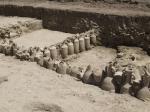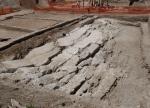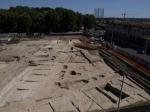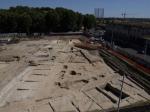Summary (English)
Between 2005 and 2009, in the Rione Testaccio, the ancient harbour and wharehouse district of the Urbs, was realised an archaeological intervention linked to the building of a new indoor market, under the surveillance of the Soprintrendenza.
The excavation of the Testaccio New Market, a four-sided area extended for one hectare, started from the street level (15 m ASL), and reached a depth of about 9 m, providing an uninterrupted stratigraphy from the Early Roman Imperial age until the Contemporary age (fig. 1). The Early Imperial period (Augustan age-Flavian period) in the North-East and then in the West part of the excavation brought to light a system of roofed rooms and open courts served by a network of service roads, which are peculiar for the building material used. All the “walls” of the structure are in fact made up of amphorae emptied and reused piling them on top of each other. At the present time, this system of rooms has been identified, in the North-East section, with a wide area of dumps for reused building material, mostly made up of amphorae and brick material; while in the West sector are rooms, probably warehouses, with well recognizable beaten earth floors (fig. 2).
The following Middle Imperial period (age of Trajan/ Hadrian) in the West sector is characterized by the excavation of the building levels of a trapezoidal edifice, identified as a horreum, made up of rows of rectangular rooms facing a wide central porticoed square, partially covered by the moderns streets via B. Franklin (West) and via A. Manunzio (North). Only the building levels of this warehouse are preserved. The horreum was, in fact, completely plundered in the antiquity (end of the III century AD-beginning of the IV century AD) up to the thresholds of the ground floor and a wall collapsed in situ testified the abandonment.
In the East portion of the excavation, were found the remains of the foundations of what was identified as a building with pillars and aisles, probably coeval with the horreum, and completely plundered as well in the antiquity. On the long eastern side of the huge horreum there is a walled up passage (corridor), whose function is still uncertain- The southern portion of the corridor wall, whose remains are there preserved, provides an example of the original walls of the Middle Imperial period building. It allows to date, together with some amphora burials found on it and in the corridor, the phases of the abandonment of the area between the end of the III and the V century AD. With regard to the Middle Ages, the faint traces preserved suggest a sporadic use of the area examined, rather than a complete occupation of it. From the Renaissance, instead, the archaeological records clearly testify the agricultural use of the area and the rural landscape, which remained unchanged until the end of the XIX century, when Testaccio became a neighbourhood, even if peripheral, of the capital city, Rome .The Renaissance phase of the excavation shows records of agricultural activities, namely parallel furrows, of the vicolo della Serpe, running North-South as shown in historical maps, and of the remains of a Renaissance farmhouse. The archaeobotanical analyses on soil samples show the presence of vines and orchards, with vegetables gardens, and of little wheat, a selection rather common in the so-called “Mediterranean diversified agriculture”.
The contemporary phase of the excavation revealed the foundations of some public housing buildings known as “villinetti”, build from the Istituto Autonomo Case Popolari (today ATER) in the 1920s’, and demolished at the end of the 1960s’. After the Urban requalification intervention, in the area are hosting the indoor market, an archaeological site and, a children archaeological museum that are a part of the museo diffuso del Rione Testaccio, including also the Porticus Aemilia and the Emporium.
- Alessia Contino - Soprintendenza Archeologica di Roma
Director
- Mirella Serlorenzi - Soprintendenza Speciale Archeologia Belle Arti e Paesaggio di Roma
- Renato Sebastiani - Soprintendenza Speciale Archeologia Belle Arti e Paesaggio di Roma
Team
- Florinda Notarstefano - Università del Salento; IBAM; Claudio Capelli -Distav - Università di Genova
- Loredana Carboni
- Girolamo Fiorentino - Università del Salento
- Federica Andreacchio (SAF srl.), Silvia Festuccia (libero professionista), Anna Gallone (libero professionista), Lucina Giacopini (Saf srl), Claudio La Rocca (libero professionista), Emanuela Mariani (Saf srl), Donatella Mastrosilvestri (Saf srl), Valeria Silvia Mellace (libero professionista), Fabio Pagano (libero professionista), Daniele Putortì (libero professionista), Maria Cristina Romano (libero professionista), Roberta Tozzo (Saf srl), Giovanna Verde (libero professionista), Sabrina Zottis (Saf srl); analisi dei reperti ceramici: Maria Laura Cafini SSABAP-RM, Alba Casaramona SSABAP-RM, Sara Colantonio SSABAP-RM, Fulvio Coletti SSABAP-RM, Alessia Contino SSABAP-RM, Lucilla D'Alessandro SSABAP-MET, Federica Luccerini (libero professionista), Elena Lorenzetti (libero professionista), Valentina Mastrodonato SSABAP-RM, Barbara Porcari SSABAP-RM, Barbara Rossi SSABAP-RM, Roberta Tanganelli (libero professionista), Claudia Tempesta SSABAP-RM
- Jacopo De Grossi Mazzorin – Università del Salento
- Carlo Rosa - Istituto Italiano di Paleontologia Umana
Research Body
- MIBACT-SSABAP-RM; Università del Salento, IBAM; Istituto di Paleontologia Umana; Università di Genova
Funding Body
- Cogeim per Comune di Roma (project financing)





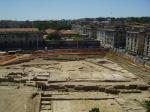
![Download [PDF]](/excavation/skins/fasti/images/results/download_sml.png)
